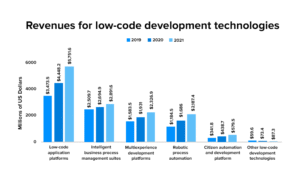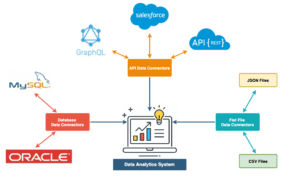Low-Code vs. No-Code: What’s Different and What’s the Future?
In the last two years, two major paradigms have been on the rise in the field of software development: low-code and no-code. These development platforms are revolutionizing conventional application development by making it possible for non-technical users as well as skilled software developers to quickly prototype, develop, and deploy applications.
But what does the term actually imply? And should freelance developers and software engineers worry about these platforms overtaking conventional development practices?
What is No-Code?

No-code is a suite of development platforms, frameworks, and tools meant to enable application development without the need to write a single line of code. The name says it all—there’s no need for programming expertise.
These platforms are generally end-to-end development environments that enable users to create fully functional web or mobile applications using visual programming methods— mostly drag-and-drop UI elements and workflow automation interfaces.
Such solutions encapsulate away infrastructure, back-end logic, and front-end styling, presenting WYSIWYG (What You See Is What You Get) editors and pre-built components to simplify the entire development life cycle for non-tech individuals.
These platforms provide drag-and-drop interfaces, pre-built components:
- Visual UI builders
- Workflow automation engines
- API integrations
- Database management
Understanding Low-Code
Now, the term low-code is very similar to no-code because low-code is just like no-code, except you can code a little bit.
Some of these platforms do allow you to write a little bit of code that you can perhaps update for particular parts of your site or web application. Maybe you can drop some JavaScript in there and modify a bit here and there or provide a little bit of scripting.

However, it’s not a full-blown programming environment where you can create a brandnew application, kind of like you could do in Rails, Python, or JavaScript or anything like that.
So, no-code, you’re not going to be writing a line of code at all. These things are very attractive right now because a lot of business users and people who are not technical can take the idea that’s in their head and build something in real time just by connecting the dots together.
There’s a ton of tutorials out there. And then, of course, you’re probably going to touch into various things of low-code if you need to do any type of scripting. However, if not required, you can completely build an application with no-code.
Popular no-code tools include:
- Bubble
- Glide
- Airtable
- Zapier
- Adalo
Does This Mean Developers Are Out of Jobs?
Does that imply that database developers, DBAs, or software developers in general were made obsolete by the advent of Microsoft Access—which served as an early no-code/lowcode solution with some limited scripting?
No, it merely implied that the problem domain changed. Developers were still needed to write shell scripts, construct system integrations, implement backend services, and engineer scalable custom applications.
Software engineers have been crucial to driving technical solutions throughout. The complexity did not disappear—just changed. These platforms allowed for the creation of prototypes, testing business rules, and proof-of-concepts by non-technical stakeholders. When limits of operation were reached, then developers were introduced to craft stable, extensible systems.
There’s a ton of tutorials out there. And then, of course, you’re probably going to touch into various things of low-code if you need to do any type of scripting. However, if not required, you can completely build an application with no-code.
Popular no-code tools include:
- Custom UI logic
- Backend integrations
- Business process automation
- Advanced data modeling
Popular low-code platforms include:
- Out Systems
- Mendix
- Microsoft Power Apps
- Appian
Conclusion
No-code and low-code platforms are giving rise to a new generation of creators and facilitators who can produce faster innovation with fewer  technical obstacles. They will certainly automate some of the mundane and repetitive tasks of the past, but they will not replace developer work. Rather, they open up more sophisticated, meaningful, and innovative work.
technical obstacles. They will certainly automate some of the mundane and repetitive tasks of the past, but they will not replace developer work. Rather, they open up more sophisticated, meaningful, and innovative work.
For freelancers, startups, and developers alike, the adoption of these tools can result in increased productivity, quicker prototyping, and new business possibilities. The future is not code vs. no-code, but code and no-code, together.
